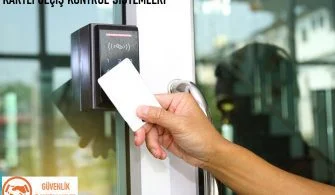How to Conduct Risk Analysis in Burglar Alarm Systems?
Risk assessment for a burglar alarm system is a process that helps identify burglary risks in a property and select appropriate alarm system components. Here are the steps that can be followed when conducting a risk assessment for a burglar alarm system:
- Assessment of the Property: The first step is the assessment of the property, which involves identifying all the inputs, outputs, and areas of the property. This step is important to gain an idea of the current theft risks in the property.
- Identification of Theft Risks: Identifying theft risks in the property is one of the most important steps in the assessment process. In this step, weak points, security vulnerabilities, and potential danger areas in the property are identified. For example, weak locking systems, easily accessible windows, or areas without security cameras.
- Identification of Needs: After identifying theft risks, the needs for a theft alarm system should be determined. This includes identifying the sensors and other components required to properly secure all inputs, outputs, and areas in the property.
- System Planning: Once the needs are identified, a system planning should be made. This includes details such as where the sensors will be placed, where the control panel will be located, and how other components will be installed.
- System Installation and Testing: The installation of the alarm system is important to ensure proper operation. After installation is completed, the system should be tested to ensure that sensors, alarms, and other components are working correctly.
- System Maintenance: Maintenance of the theft alarm system ensures proper operation and prevents any malfunctions. Maintenance includes regularly checking, replacing, or renewing alarm system components.
The following steps can be followed to identify theft risks:
- Determine which hours the business is at a higher risk for theft. For example, theft risk may increase during hours when the business has less personnel and fewer security measures, such as at night.
- Research crime rates in the area where the business is located. Crime rates in the area can help determine the business’s risk of theft.
- Evaluate theft incidents at other businesses in the area where the business is located. The theft incidents at other businesses in the area can give an idea of the business’s risk of theft.
- Identify weak points of the business’s doors and windows in terms of theft. This shows how strong the doors and windows are and whether there are any weak points that could create an opportunity for thieves to enter the business.
- Make a list of the valuable items and other materials inside the business. This can help determine what type of valuable items or materials thieves could steal.
- Evaluate the business’s security measures. Security cameras, alarm systems, lighting, and other measures play an important role in reducing the business’s risk of theft.
- Train the business’s staff on theft risk. Staff should be trained on what steps to take to reduce the business’s risk of theft.
- Identify possible entry points that thieves could use to enter the business. This includes reviewing areas outside the business, surrounding structures, vehicles, and other potential entry points.
- Review the lighting in the area where the business is located. Lighting can increase visibility if thieves approach the business and can prevent them from escaping.
Burglar Alarm System Sensor Placements:
Burglar alarm systems are a security network created by placing various sensors. The sensors detect movement, vibration or temperature in specific areas of the business to detect burglary. Sensor placement is determined based on the needs of the business, and the sensor placement may vary for each business. However, the following sensors are generally used and placed in specific locations:
- Motion sensors: Motion sensors detect human movement within a business. These sensors are typically placed at the entrances to protected areas, in hallways, and at the exterior doors of the business.
- Door/window sensors: Door/window sensors are magnetic sensors that trigger the alarm when doors or windows are opened or closed. These sensors are usually placed on door and window frames or door handles.
- Vibration sensors: Vibration sensors detect abnormal vibrations such as glass breaking. These sensors are typically placed near glass doors and windows.
- Temperature sensors: Temperature sensors trigger the alarm when the business exceeds a certain temperature range. These sensors are usually placed near the ventilation or climate control systems of the business.
- Smoke/fire sensors: Smoke/fire sensors detect smoke or fire within the business and trigger the alarm. These sensors are usually mounted on the ceiling or walls of the business.
Proper placement and positioning of sensors increase the effectiveness of the burglar alarm system and reduce false alarm triggers. Sensor placement is determined according to the needs of your business and positioned correctly.
Burglars can use various techniques to break into buildings. The most common ones include
- Lock picking: Thieves can try to pick the lock of a door by inserting a blank key or a special tool into the keyhole. Therefore, doors should be equipped with high-quality and secure locks, preferably with double-sided locking feature.
- Window breaking: Thieves can enter a building by breaking the window glass. Therefore, windows should be replaced with secure, thick glass or double-pane windows. Additionally, reinforcing the locks and handles on the window edges can be beneficial.
- Wall climbing: Thieves can climb or drill through the walls to enter the building. Therefore, walls should be made strong and sturdy.
- Roof entry: Thieves can enter the building by climbing onto the roof or creating a hole on the roof. Therefore, roofs should be strong and secure.
- Key duplication: Thieves can enter a building by duplicating or stealing keys. Therefore, it is important to store keys securely and limit access to them.
Information on Burglary Statistics.
The number of theft incidents vary by country, region, and even cities. Additionally, the accuracy and currency of the data is important.
For instance, according to a report published by the FBI, approximately 7.9 million property crime offenses were recorded in the United States in 2019. This figure represents a 2.1% decrease from the previous year.
In Europe, a report published by Europol indicates that a total of 1.3 million burglaries were recorded in 2018. This figure represents a 2.1% increase from the previous year.
In Turkey, according to statistics published by the General Directorate of Security, approximately 154,000 theft incidents were recorded in 2019. This figure represents a 6.2% decrease from the previous year.
However, it should be noted that not all theft incidents are reported and official data may not fully reflect the actual situation. Additionally, areas where theft incidents increase or decrease may vary and have different risk profiles.








